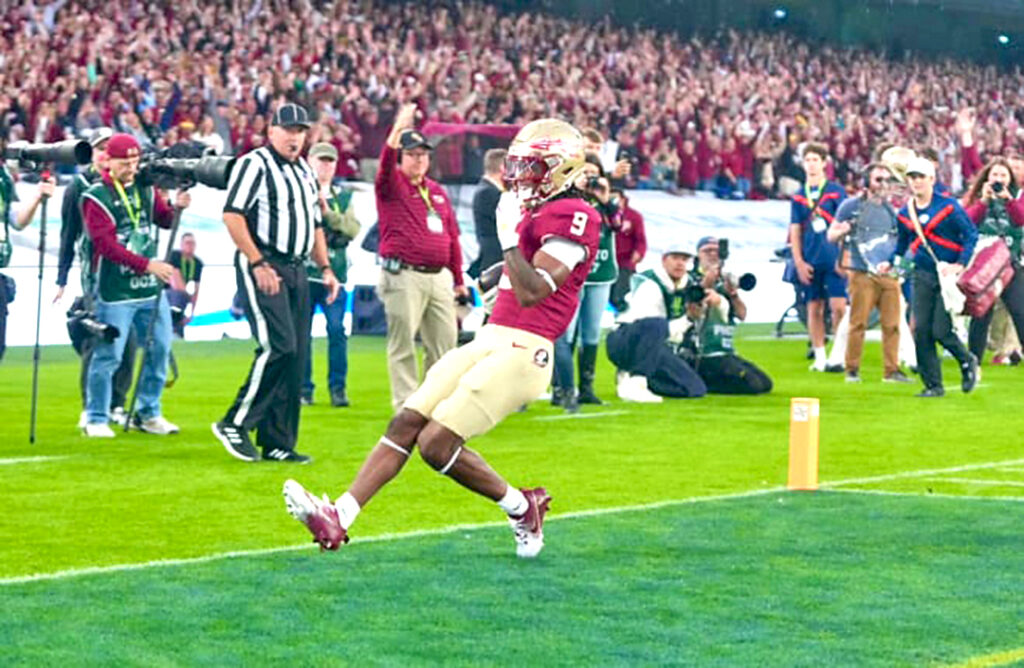Some quick takeaways, notes from FSU’s loss to GT


By BOB FERRANTE
Editor The Osceola
A season of change but one that began with great expectations now instead opens with a stunning, and stinging, loss.
Jamal Haynes ran for 75 yards and two touchdowns and Aidan Birr made a 44-yard field-goal attempt with no time left as Georgia Tech upset No. 10 Florida State 24-21 in the teams’ season opener on Saturday.
Haynes King threw for 146 yards and ran for 54 yards as the Yellow Jackets (1-0, 1-0 ACC) were able to control the line of scrimmage and accumulate 190 rushing yards, averaging 5.3 yards per carry.
“They did a good job of extending drives and obviously making the plays that were necessary there to the end,” FSU coach Mike Norvell said. …
“For our football team, it’s about where our response goes from here. Obviously, we’re all hurt. You come, you work, you want to start off a season a certain way. We came up short of that tonight.”
DJ Uiagalelei was efficient in completing 19 of 27 passes for 193 yards in his Florida State debut. While he didn’t throw a touchdown pass or interception, he completed a pair of passes on fourth-and-long as the Seminoles (0-1, 0-1) tied the game at 21-21 with 8:18 to go.
Roydell Williams and Lawrance Toafili each had touchdown runs for the Seminoles, who couldn’t dictate up front and just 98 yards on 31 carries (just 3.2 yards per carry).
Ryan Fitzgerald made a 59-yard field-goal attempt, a career long and the second-longest in school history, just before halftime to tie the game at 14. Fitzgerald added a 52-yarder earlier in the game.
EVERY POSSESSION MATTERED
FSU had just seven possessions. GT’s final drive was its seventh.
It’s tough to see a result like this when FSU delivers points on four of its seven drives. But it’s also a result of using the huddle and the new clock rules.
And it’s also a curious philosophical question: Why is FSU huddling? Is making the game shorter part of Norvell’s overall viewpoint of draining the clock, a departure from the tempo that he has shown in his years at Memphis and FSU.
“Very limited possessions,” Norvell said. “The importance of every snap in that game was monumental.”
FSU had just four first-half drives, scoring a touchdown and a pair of field goals — including Ryan Fitzgerald’s end-of-half 59-yarder. Georgia Tech had three first-half drives.
When drives are at a premium, it puts stress on an offense to deliver despite the limited at-bats. Early on, FSU was efficient despite lacking explosiveness.
While FSU didn’t fire passes deep, DJ Uiagalelei was 12 of 14 for 96 yards in the first half. FSU’s run game picked up 78 yards, averaging 5.6 yards per carry. It helps when Lawrance Toafili breaks off a 28-yard touchdown run to cap an impressive first drive, but FSU’s line was able to clear holes.
First downs, let alone scores, were a premium in the second half. FSU had a pair of six-play drives in the third quarter. The defense forced a three-and-out and GT missed a field-goal attempt, but the Yellow Jackets went ahead 21-14 with a methodical 11-play, 89-yard drive that wrapped up with Jamal Haynes’ 2-yard TD on the first play of the fourth quarter.
The Seminoles put together an epic eight-minute drive in the fourth quarter, with Uiagalelei converting twice on fourth-and-long as FSU tied up the game at 21.
FSU’S STRUGGLES
VS. THE RUN
GT’s ground game was among the best in the nation in 2023, boosted by a mobile quarterback and Jamal Haynes. On Saturday, the Yellow Jackets ran 36 times for 190 yards (an average of 5.3 yards per carry).
FSU’s defensive front – a highly regarded line as well as a linebacking corps that looked to be improving in the offseason – struggled to wrap up the Yellow Jackets.
On a day when drives were at a premium, GT had scoring drives of 6, 14, 11 and 12.
Good defenses can stop, or at least limit, the run. FSU has some work to do.


